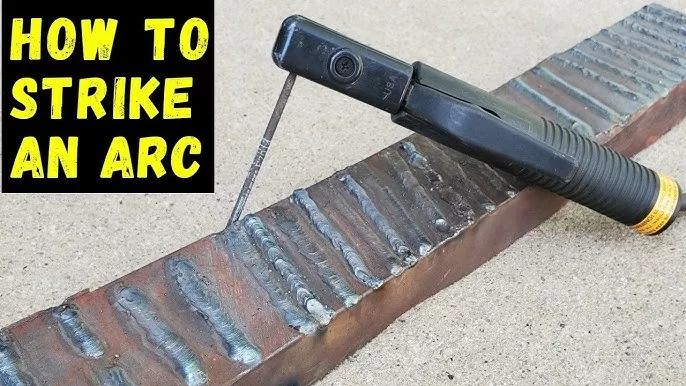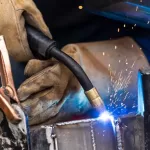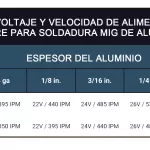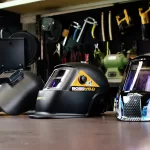Learning how to properly strike an arc when arc welding can be quite a headache. There are a few methods to strike an arc and we will go over them here. The one thing that probably makes it the most difficult is that you cannot see what you are doing, so I strongly recommend getting an auto darkening welding helmet. It will probably be the most important investment you will make on your quest to learn how to arc weld.
Learn Stick in Welding Training
Welding Town
The basic theory behind how to strike an arc is simple. You must make the metal of the electrode contact the metal you are welding on. It must then be immediately drawn away from the metal about 1/4 of an inch. If you do not draw it away it will simply stick to your work. If that happens a quick twist and tug will usually get it loose. If it doesn’t break free on the first try you will want to squeeze the clamp on the electrode holder and pull that away. Keep in mind any time the electrode is stuck to your work, the welder is being shorted out. This will cause it to overheat much quicker, and may blow a fuse or breaker in your breaker box.
There are a few techniques on how to strike an arc, I recommend you try them all and see which is most comfortable for you. Remember, practice is the key to being a good welder. The first method is the jab method. The way this works is you position the electrode about 1/2 an inch away from your work. Then flip your helmet down. Now you want to quickly jab the rod into the work then immediately pull it back. Another method is the scratch method. This method works very much like striking a match. Just imagine the electrode is the match, and the location you wish to lay your welding bead is the striker. If you make sure to use a very quick stroke you are much less likely to have your electrode stick when using this method.
One common problem people have is that no matter what the electrode simply freezes to the work. If you are experiencing this, it most likely means that the amps need to be turned up on your welder. Try turning it up 10 amps at a time until it stops sticking. If you are having success getting the arc to start, but then it immediately goes out, you are pulling the welding rod too far away from your work. Remember, you only want to pull it back about a 1/4 of an inch.
Once you have the arc going, you need to immediately start feeding the electrode into it. The electrode will get burned up fairly quickly, so you must keep it at the correct distance to maintain the arc. When it is at the correct distance it will make a crackling noise. If you get it too far away it will be more of a popping noise with sparks flying in all directions. If it is too close you will see the arc start to go out and it will make much less noise. If the arc goes out after you have been welding a little you can restart it much easier while the metal is still molten. Simply stick the electrode back into the puddle while you can still see it glowing through your mask.
Sometimes it is necessary to have the arc start in exactly the right place. This can be difficult without an auto darkening helmet. One trick is to place a small piece of scotch tape on the metal that ends right where you want the bead to start. This way you can place the electrode on the tape with your helmet up, then drop your helmet and simply drag it off the tape.
Learning how to strike an arc can be one of the most frustrating steps in learning how to arc weld. Fortunately, once you get it down, it becomes almost natural. Learning how to arc weld is mostly a process of practice. Get yourself some scrap metal and spend a few afternoons burning up electrodes before you try to weld anything important.
Start with Proper Stick Welding Setup
Stick welding can be a great process for young welders to learn because the equipment can be relatively inexpensive, and the process is often used at a host of different kinds of job sites.
However, because stick is a manual welding process, it can be more challenging than automatic techniques like MIG welding. This can make learning the basics of stick welding especially important, as they can serve as a foundation on which to build your welding skills.
Before even attempting to strike the arc, consider these steps for setting up a successful stick weld.
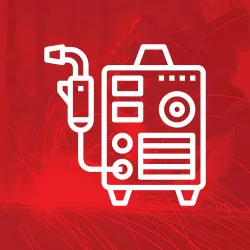
Step 1. Select the Right Machine
It’s important to start by selecting the right welding machine. Consider the duty cycle and amperage draw when choosing a power source. Portability needs and available power sources at the locations you’ll be working in, specifically the available voltage and whether single-phase or three-phase power, can be other factors.

Step 2. Choose the Appropriate Electrode
Which electrode should you choose? That depends on the type of metal you’re working with, your welding position and the welding specifications given for the job.
Popular Stick Electrodes
- 6010: for materials with rust or oil
- 7014: for clean surfaces
- 7018: for code work in industrial applications

Step 3: Setup Your Machine Correctly
Check the electrode packaging for the correct polarity to use. Beware that too high of a current range could cause spatter and too low of one could make striking and maintaining the arc a struggle.
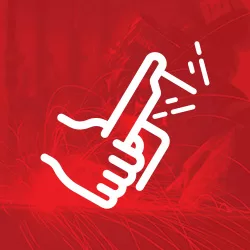
Step 4: Strike the Arc Properly
The 4th step of proper stick welding setup is usually striking the arc.
Unlike in MIG welding, which has a button to start the arc, the stick welding electrode becomes live with the flip of the welding machine switch. This can make knowing how to strike a stick welding rod an important skill.
To start the arc, the circuit created between the neutral clamp and the hot rod must be completed. This is accomplished by momentarily touching the rod to the work, referred to as starting the arc.
Ideally, you should hold your arc length to between 1/8 inch and 1/4 inch from the work surface. If you hold your electrode’s tip too close to the surface of the workpiece, you risk the chance that the arc will end up buried in the molten metal, snuffing it out and requiring the arc to be restarted.
It’s a tricky process because moving too slow or too fast can result in welding the rod to the work. The two common ways welders get it done are tap starting and scratch starting.
Tap Start versus Scratch Start
1. Tap Start
Tap starting is used more commonly because of the reduced risk of having the rod stick to your workpiece.
To tap start your arc, you’ll need to sharply tap the tip of your rod against the work where you want to start the weld. This helps to remove excess flux from the rod’s end.
You’ll need to use a sharp wrist action to allow momentary contact with the workpiece, then you’ll pull the rod a short distance away.
You’ll notice the light from the arc starts out very bright because the initial arc length is too long. However, this length is quickly reduced to the proper distance when you begin welding.
Many welders find it’s much easier to start the rod on the second attempt, starting the arc initially on scrap material before you start the arc at the beginning of your weld.
2. Scratch Start
Another option you can consider when starting your weld is a scratch start, which has its own advantages in specific situations.
Scratch the rod against the work. You’ll begin to see sparks, at which point you’ll lift the rod. Many welders use a backward and forward scratching motion to remove the flux coating on the rod. By limiting the motion of your scratch start, you’ll get an arc starting close to where you want to begin welding.
Because it relies on human reaction times, using a scratch-start technique can have more issues with the rod sticking to the work surface. However, it may be a good technique to keep in your toolkit when you’re dealing with rods that are hard to start or when you’re working with AC welders or welders that have lower open-circuit voltage, which tends to make the tap-starting technique difficult.
Learn Stick in Welding Training
Now you know more about proper stick welding setup, including the two main ways to strike the arc.







